Power Quality and Rooftop-Photovoltaic Households: An Examination of Measured Data at Point of Customer Connection
Abstract
:1. Introduction
“...the variations in solar production are causing all sorts of problems with local electrical infrastructure ... it causes the voltage at the transformer to increase ... this excessive voltage is causing problems, such as power trips and appliance failure, for all consumers on the electrical network as electrical appliances are designed to use 240v.”[31]
2. Materials and Methods
2.1. Power Quality Standards
2.1.1. Frequency Standards
2.1.2. Voltage Standards
2.1.3. Power Factor Standards
2.2. Case Studies
2.2.1. Case Studies for Quantitative Data
2.2.2. Case Studies—Supplementary Qualitative Data
2.3. Quantitative Data Collection and Validation Methods
2.4. Quantitative Data Analysis and Validation Method
3. Results
3.1. Annual and Monthly Power Quality
- The lowest voltage variation in Queensland was in May, with all other months showing a consistently high monthly mean variation (above 240 V) of approximately 10 V;
- The Victorian house had monthly variations ranging from a low of 6 V (July) to a high of 16 V (August);
- The mean monthly voltage variations in the Western Australian house were less extreme, however there is a suggestion that the variations were less pronounced once the house was inhabited (in late March 2016);
- The South Australian house showed the highest mean monthly voltage, ranging between 15 and 22 V over the 230 V standard. The data shows two months when voltages were outside of the standard.
3.2. Depicting Voltage Variation
- The Queensland house (Figure 4a) showed the highest voltages occur during the middle of the day, suggesting a possible link with PV generation. However, there were also high voltages in the evening (19:00–23:00) and, to a lesser extent, early morning (01:00–05:00). These high voltages cannot be attributed to PVs.
- The South Australian data (Figure 4b) showed power outages in January and March 2016 and quite dramatic voltage variations occurring in summer and outside of daylight hours. The data appears to be valid as frequency and power factor data at these times was within normal limits. These variations (outside of daylight hours) cannot be attributed to PVs.
- The Victorian data (Figure 4c) also showed some power outages as well as a few occurrences of low voltage. Very little overvoltage was seen.
- The Western Australian house (Figure 4d) showed voltage variations (but not as extreme as South Australia). This house, however, has no rooftop PV, has gas hot water and was unoccupied until late March. This would seem to indicate that the data measured at this location is a true indication of voltage fluctuations on this network transformer. Note that there are significant periods of missing data.
3.3. Possible Contributors to Voltage Variations
3.3.1. Relationship of House to Distribution Network Transformer
3.3.2. Correlation with Solar Generation
- As expected the Queensland house (Figure 7a) showed highest solar generation around midday and the highest solar generation was in August/September (the driest months with the clearest skies and the tilt of the PVs is more closely matched to the sun angle). The low solar generation in the last week of February and March can be explained by poor weather conditions during that period of time [18]. Figure 4a however (the voltage graph) shows high voltage during February/March and no further increase in voltages in August/September, suggesting that there is no link between solar radiation, PV output and supply voltage fluctuations measured at that house at those times.
- For the South Australian house a comparison of supply voltage fluctuations (Figure 4b) and solar generation (Figure 7b) shows no correlation in time of day or time of year. It is not known whether the microinverters of this PV system present any advantages or disadvantages over the more common string inverters, in terms of power quality.
3.3.3. Correlation with Household Loads
3.4. Supplementary Data from Additional Case Studies
4. Discussion
4.1. Historical Network Management
Historically, the survival of a local electric company did not depend on its efficiency. In fact, a 'sloppy' operation could do just fine financially. That’s because utilities were usually the sole supplier of a needed product and were allowed to price at a level that gave them a prescribed return upon the capital they employed... That’s all changing.[53]
- 15% of three urban feeders studied were outside of the 240 V standard; and 29% were outside of the 230 V standard; this inferred that only 70% of the LV network was compliant with voltage requirements.
- They have not managed/reset distribution transformer tap changers to manage voltage fluctuations at a transformer level even though their analysis suggests that 26.6% of currently non-compliant LV networks could be resolved through a transformer tap change. However, due to the high cost and small number of qualified and specialized manufacturers for on load tap changers, they consider it is not possible to equip on load tap changers to distribution transformers to actively manage voltage across a day or season. Therefore, load shedding is needed to reset the distribution transformer tap. This requires considerable planning and notifications to affected customers.
- The company has significant gaps in their data/knowledge about their own network, particularly at a distribution transformer level and below. For example, they do not have accurate records of what tap position the transformer fleet is set to (although they are working to rectify this). They do not know what supply voltages are experienced by the customers. They have a poor understanding of customer loads such as the ratio of constant power loads to resistive loads at peak demand.
4.2. Missed Opportunities for Better Network Management
4.3. Redefining Relationships with Residential Prosumers
4.4. Lessons from a Quality Management System
5. Conclusions
Acknowledgments
Author Contributions
Conflicts of Interest
Glossary
| CT clamp | current transformed clamp |
| DNSP | distribution network service provider |
| HEMS | home energy management system |
| IQR | inter quartile range |
| LV | low voltage |
| LVDN | low voltage distribution network |
| PCC | point of common coupling (from network to residential premises) |
| pf | power factor |
| PoA | point of attachment (network to residential premises) |
| PV | photovoltaic |
References
- European Commission. 2030 Climate & Energy Framework. Available online: http://ec.europa.eu/clima/policies/strategies/2030_en (accessed on 31 January 2017).
- Morris, C. Germany May Reach Its 2020 Target for Renewable Power This Year. Available online: http://reneweconomy.com.au/will-germany-reach-2020-target-renewable-power-year-74293/ (accessed on 31 January 2017).
- The White House. Executive Order—Planning for Federal Sustainability in the Next Decade, Executive Order 13693 ed.; Office of the Press Secretary: Washington, DC, USA, 2015. [Google Scholar]
- World Resources Institute. Renewable Energy in China: An Overview; World Resources Institute: Washington, DC, USA, 2014. [Google Scholar]
- Clean Energy Regulator. The Renewable Energy Target 2014 Administrative Report; Australian Government: Canberra, Australia, 2015.
- U.S. Energy Information Administration. International Energy Outlook 2016; U.S. Energy Information Administration: Washington, DC, USA, 2016.
- Mirhassani, S.; Ong, H.C.; Chong, W.T.; Leong, K.Y. Advances and challenges in grid tied photovoltaic systems. Renew. Sustain. Energy Rev. 2015, 49, 121–131. [Google Scholar] [CrossRef]
- Haque, M.M.; Wolfs, P. A review of high pv penetrations in lv distribution networks: Present status, impacts and mitigation measures. Renew. Sustain. Energy Rev. 2016, 62, 1195–1208. [Google Scholar] [CrossRef]
- Eltawil, M.A.; Zhao, Z. Grid-connected photovoltaic power systems: Technical and potential problems—A review. Renew. Sustain. Energy Rev. 2010, 14, 112–129. [Google Scholar] [CrossRef]
- Tratnam, E.L.; Well, S.R.; Kellett, C.M. Central versus localized optimization-based approaches to power management in distribution networks with residential battery storage. Int. J. Electr. Power Energy Syst. 2016, 80, 396–406. [Google Scholar] [CrossRef]
- Penido, D.R.R.; Araujo, L.R.; Carneiro, S.; Pereira, J.L.R.; Garcia, P.A.N. Power Factor Correction on Distribution Networks Including Distributed Generation. In Proceedings of the IEEE Power Engineering Society General Meeting, Tampa, FL, USA, 24–28 June 2007; pp. 1–6. [Google Scholar]
- Pompodakis, E.E.; Drougakis, I.A.; Lelis, I.S.; Alexiadis, M.C. Photovoltaic systems in low-voltage networks and overvoltage correction with reactive power control. IET Renew. Power Gener. 2016, 10, 410–417. [Google Scholar] [CrossRef]
- Khuleedee, W.; Kaewrawang, A.; Tonmitr, K. Impact of on-grids solar pv rooftop on low voltage grid systems: A case study of pea udonthani, thailand. Appl. Mech. Mater. 2015, 781, 296. [Google Scholar] [CrossRef]
- Obi, M.; Bass, R. Trends and challenges of grid-connected photovoltaic systems—A review. Renew. Sustain. Energy Rev. 2016, 58, 1082–1094. [Google Scholar] [CrossRef]
- Watson, G.D.; Watson, N.R.; David, S.-M.; Wood, A.R.; Lemon, S.; Miller, A.J.V. Impact of solar photovoltaics on the low-voltage distribution network in new zealand. IET Gener. Transm. Distrib. 2016, 10. [Google Scholar] [CrossRef]
- Shahnia, F.; Majumder, R.; Ghosh, A.; Ledwich, G.; Zare, F. Voltage imbalance analysis in residential low voltage distribution networks with rooftop pvs. Electr. Power Syst. Res. 2011, 81, 1805–1814. [Google Scholar] [CrossRef]
- Rafi, F.H.M.; Hossain, M.J.; Lu, J. Hierarchical controls selection based on pv penetrations for voltage rise mitigation in a lv distribution network. Int. J. Electr. Power Energy Syst. 2016, 81, 123–139. [Google Scholar] [CrossRef]
- Guinane, A.; McPhail, D.; Gorman, M. Impacts of voltage transition from 240v to 230v voltage. In Proceedings of the Australasian Universities Power Engineering Conference (AUPEC), Brisbane, Australia, 26–29 September 2016. [Google Scholar]
- Shivashankar, S.; Mekhilef, S.; Mokhlis, H.; Karimi, M. Mitigating methods of power fluctuation of photovoltaic (pv) sources—A review. Renew. Sustain. Energy Rev. 2016, 59, 1170–1184. [Google Scholar] [CrossRef]
- Kouro, S.; Leon, J.I.; Vinnikov, D.; Franquelo, L.G. Grid-connected photovoltaic systems: An overview of recent research and emerging pv converter technology. IEEE Ind. Electron. Mag. 2015, 9, 47–61. [Google Scholar] [CrossRef]
- Alam, M.J.E.; Muttaqi, K.M.; Sutanto, D. Alleviation of neutral-to-ground potential rise under unbalanced allocation of rooftop pv using distributed energy storage. IEEE Trans. Sustain. Energy 2015, 6, 889–898. [Google Scholar] [CrossRef]
- Karimi, M.; Mokhlis, H.; Naidu, K.; Uddin, S.; Bakar, A.H.A. Photovoltaic penetration issues and impacts in distribution network—A review. Renew. Sustain. Energy Rev. 2016, 53, 594–605. [Google Scholar] [CrossRef]
- Georgilakis, P.S.; Harziargyriou, N.D. A review of power distribution planning in the modern power systems era: Models, methods and future research. Electr. Power Syst. Res. 2015, 121, 89–100. [Google Scholar] [CrossRef]
- Singh, B.; Chandra, A.; Al-HAddad, K. Power Quality: Problems and Mitigation Techniques; Wiley: West Sussex, UK, 2015. [Google Scholar]
- Blumsack, S. Why Rooftop Solar Is Disruptive to Utilities—And the Grid. Available online: https://theconversation.com/why-rooftop-solar-is-disruptive-to-utilities-and-the-grid-39032 (accessed on 2 February 2017).
- Tlozek, E. Qld Electricity Providers Trying to Block Solar from Grid, Lobby Group Says. Available online: http://www.abc.net.au/news/2014-07-08/qld-providers-trying-to-block-solar-from-grid-groups-says/5579874 (accessed on 8 July 2014).
- Slezak, M. Australia‘s Polictics Only Barrier to Clean Energy System, Report Finds. Available online: https://www.theguardian.com/australia-news/2017/oct/05/australias-politics-only-barrier-to-clean-energy-system-report-finds (accessed on 5 October 2017).
- Warrick, J. Utilities Wage Campaign against Rooftop Solar. Available online: https://www.washingtonpost.com/national/health-science/utilities-sensing-threat-put-squeeze-on-booming-solar-roof-industry/2015/03/07/2d916f88-c1c9-11e4-ad5c-3b8ce89f1b89_story.html?utm_term=.7ba37c86d47b (accessed on 2 February 2017).
- Hepworth, A. Rooftop Solar Panels Overloading Electricity Grid. Available online: http://www.theaustralian.com.au/news/rooftop-solar-panels-overloading-electricity-grid/news-story/5ea583571dde0830ec34d3cd8c32b9dc (accessed on 12 April 2018).
- Too Much Solar Power Could Overload National Grids, Warns Expert. Available online: http://www.dailymail.co.uk/sciencetech/article-1324264/Too-solar-power-overload-national-grid-warns-German-energy-expert.html (accessed on 7 March 2018).
- GEM Energy. Technical Aspects—Connecting to the Grid. Available online: https://www.gemenergy.com.au/technical-aspects-connecting-to-the-grid/ (accessed on 7 March 2017).
- Barbato, A.; Dede, A.; Della Giustina, D.; Massa, G.; Angioni, A.; Laipari, G.; Ponci, F.; Repo, S. Lessons learnt from real-time monitoring of the low voltage distribution network. Sustain. Energy Grids Netw. 2017. [Google Scholar] [CrossRef]
- Neuman, W.L. Social Research Methods: Qualitative and Quantitative Approaches, 7th ed.; Allyn & Bacon: Boston, MA, USA, 2011. [Google Scholar]
- Creswell, J.W. Research Design: Qualitative, Quantitative and Mixed Methods Approaches; SAGE Publications: Thousand Oaks, CA, USA, 2009. [Google Scholar]
- Abowitz, D.A.; Toole, T.M. Mixed method research: Fundamental issues of design, validity and reliability in construction research. J. Constr. Eng. Manag. 2010, 136, 108–116. [Google Scholar] [CrossRef]
- Reliability Panel. Review of the Frequency Operating Standard, Issues Paper 14 July 2017; Australian Energy Market Commission (AEMC): Canberra, Australia, 2017.
- Australian Energy Market Commission (AEMC) Reliability Panel. Application of Frequency Operating Standards during Periods of Supply Scarcity: Final Determination; AEMC: Sydney, Australia, 2009.
- Markiewicz, H.; Klajn, A. Voltage Disturbances: Standard en 50160—Voltage Characteristics in Public Distribution Systems; European Copper Institute, Wroclaw University of Technology and Copper Development Association: Hemel Hempstead, UK, 2004. [Google Scholar]
- National Grid Electricity Transmission plc. The Grid Code, Issue 5, Revision 21; National Grid Electricity Transmission plc: Great Britain, UK, 2017. [Google Scholar]
- New Zealand Government. Electricity Industry Participation Code 2010; New Zealand Government: Okiato, New Zealand, 2010.
- The South African Grid Code—System Operation Code South Africa. Available online: http://www.nersa.org.za/Admin/Document/Editor/file/Electricity/Compliance%20Monitoring/SAGC%20Network%20Version%207_March%202008.pdf (accessed on 12 April 2018).
- Swedish Standard. Voltage Characteristics of Electricity Supplied by Public Electricity Networks; German Institute for Standardisation: Berlin, Germany, 2010. [Google Scholar]
- Standard, B. Bs7671: 2008+a3: 2015—Requirements for Electrical Installation. Iet Wiring Regulations. Available online: https://shop.bsigroup.com/ProductDetail?pid=000000000030292893 (accessed on 12 April 2018).
- American National Standards Institute (ANSI). Ansi c84.1-2016: American National Standard for Electrical Power Systems and Equipment—Voltage Ratings (60 Hertz); National Electrical Manufacturers Association: Rosslyn, VA, USA, 2016. [Google Scholar]
- Australian Standard. As 61000.3.100-2011: Electromagnetic Compatibility (emc)—Limits—Steady State Voltage Limits in Public Electricity Systems. Available online: https://www.techstreet.com/standards/as-61000-3-100-2011-amdt-1-2016?product_id=1913602 (accessed on 12 April 2018).
- Halliday, C.; Elder, L. Power Factor Correction—The Easiest, Biggest, Green Initiative. Available online: http://www.powerlogic.com.au/electrical-policies-and-procedures_11_2895948716.pdf (accessed on 12 April 2018).
- Miller, W.; Senadeera, M. Social transition from energy consumers to prosumers: Rethinking the purpose and functionality of eco-feedback technologies. Sustain. Cities Soc. 2017, 35, 615–625. [Google Scholar] [CrossRef]
- Miller, W.; Liu, A.L.; Amin, Z.; Gray, M. Involving occupants in net-zero-energy solar housing retrofits: An australian sub-tropical case study. Sol. Energy 2018, 159, 390–404. [Google Scholar] [CrossRef]
- Zedan, S.; Miller, W. Quantifying stakeholders‘ influence on energy efficiency in housing: Development and application of a four-step methodology. Constr. Manag. Econ. 2017, 1–19. [Google Scholar] [CrossRef]
- Miller, W.; Amin, Z.; Zedan, S. Steel sips for residential building construction: Lessons from air leakage and thermography analysis of australian houses. J. Archit. Eng. 2017, 23, 04017012. [Google Scholar] [CrossRef]
- EnOB—Research for Energy Optimized Building. Monisoft—Software for Monitoring and Energetic Performance Optimisation. Available online: http://www.enob.info/en/software-and-tools/projects/details/monisoft-software-for-monitoring-and-energetic-performance-optimisation/ (accessed on 1 February 2017).
- Franz, J. California‘s Electrical Grid Can‘t Handle All the Solar Energy the State Is Producing. Available online: https://www.pri.org/stories/2017-07-20/california-s-electrical-grid-can-t-handle-all-solar-energy-state-producing (accessed on 7 March 2018).
- Buffett, W.E. Chairman’s Letter, Berkshire Hathaway Inc. 2015 Annual Report; Berkshire Hathaway Inc.: Omaha, Nebraska, 2016. [Google Scholar]
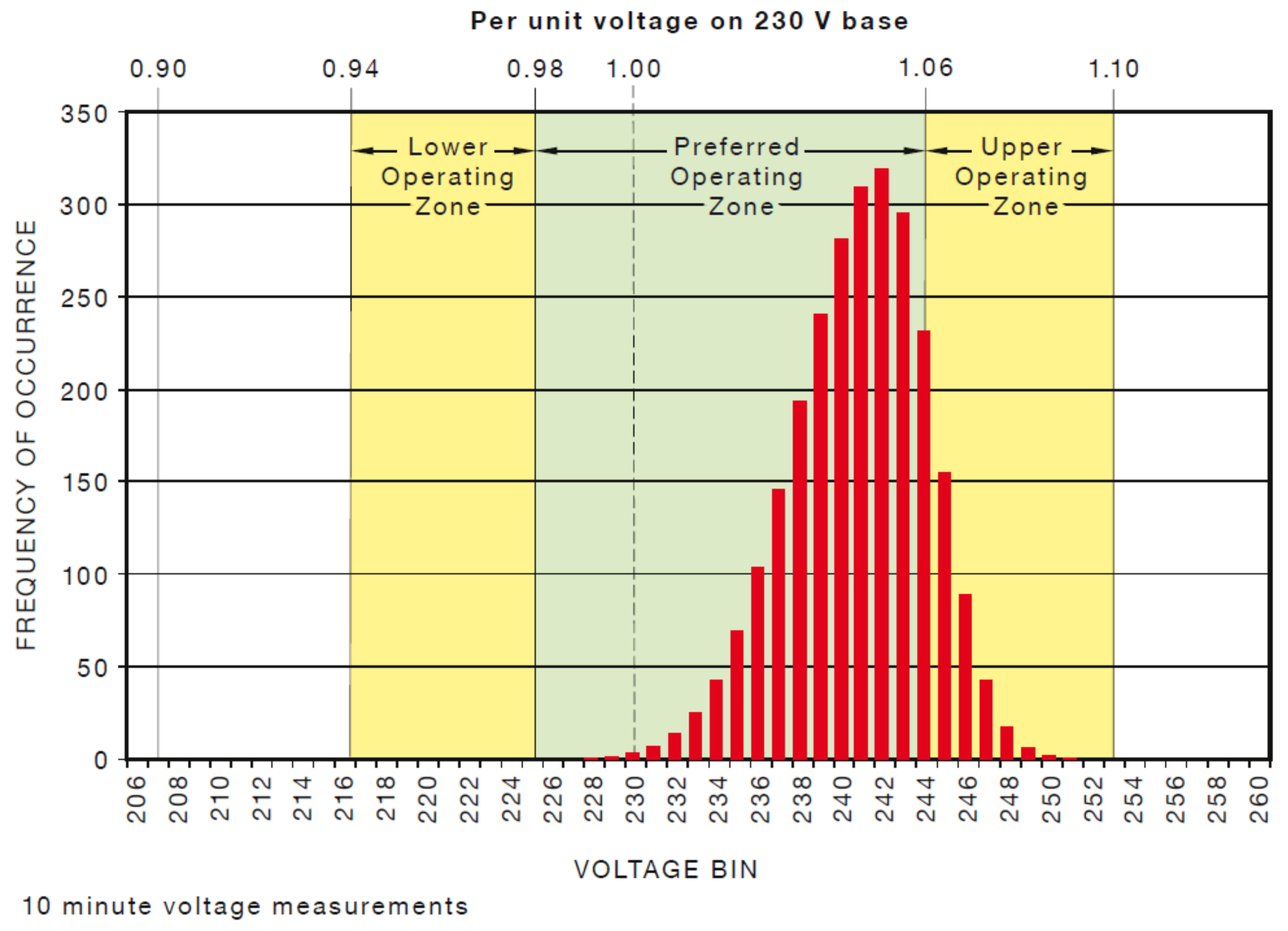
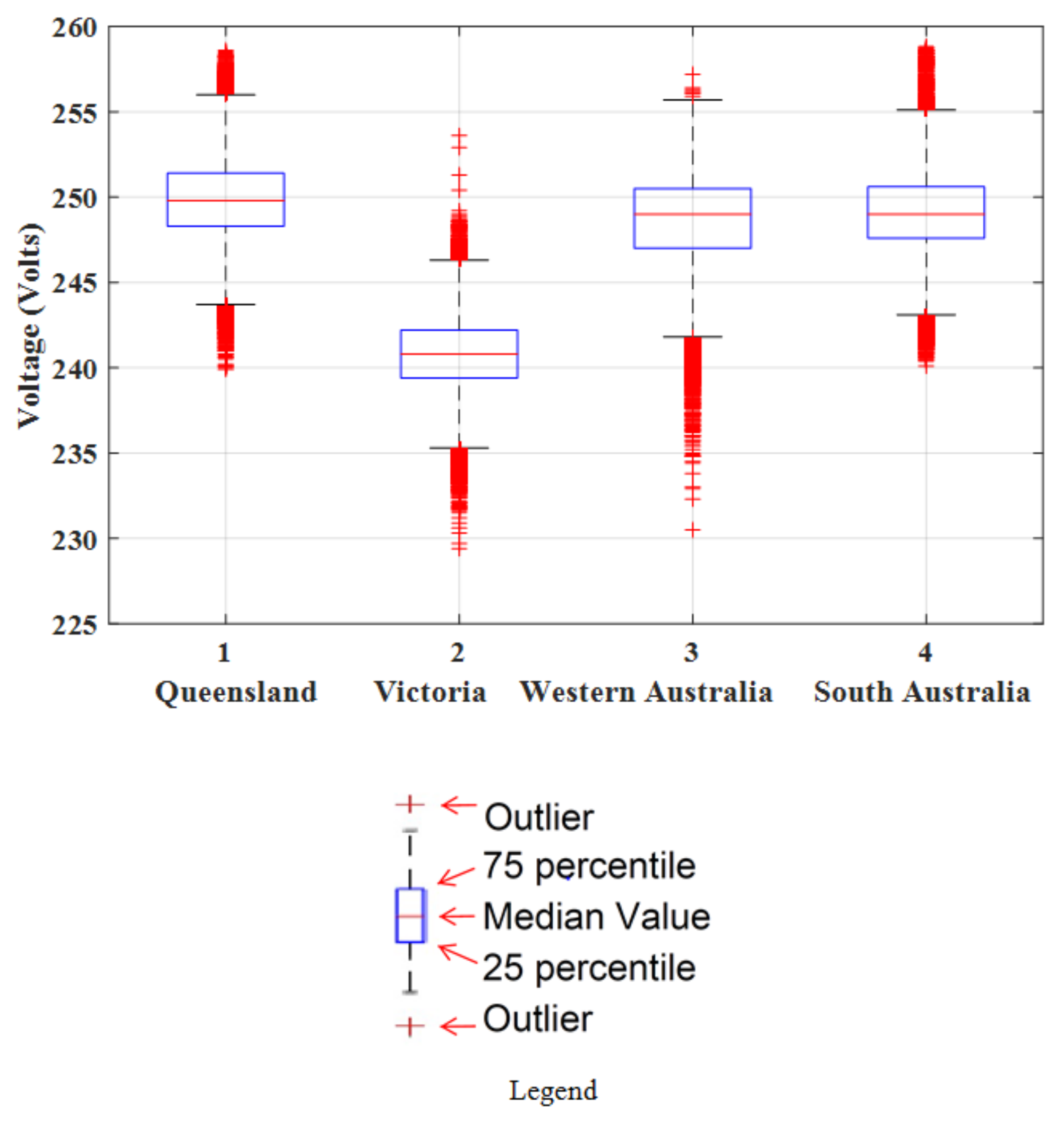
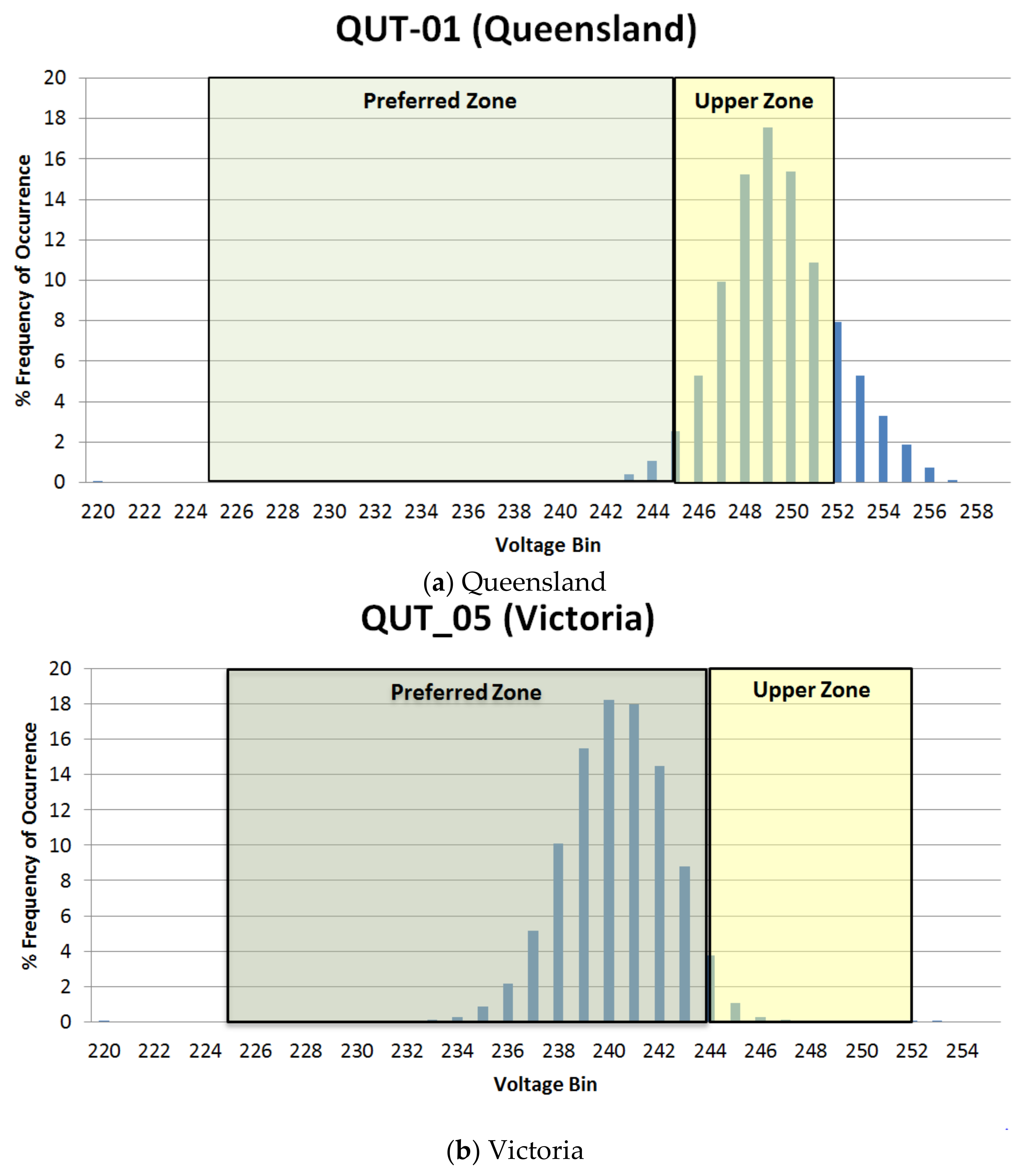
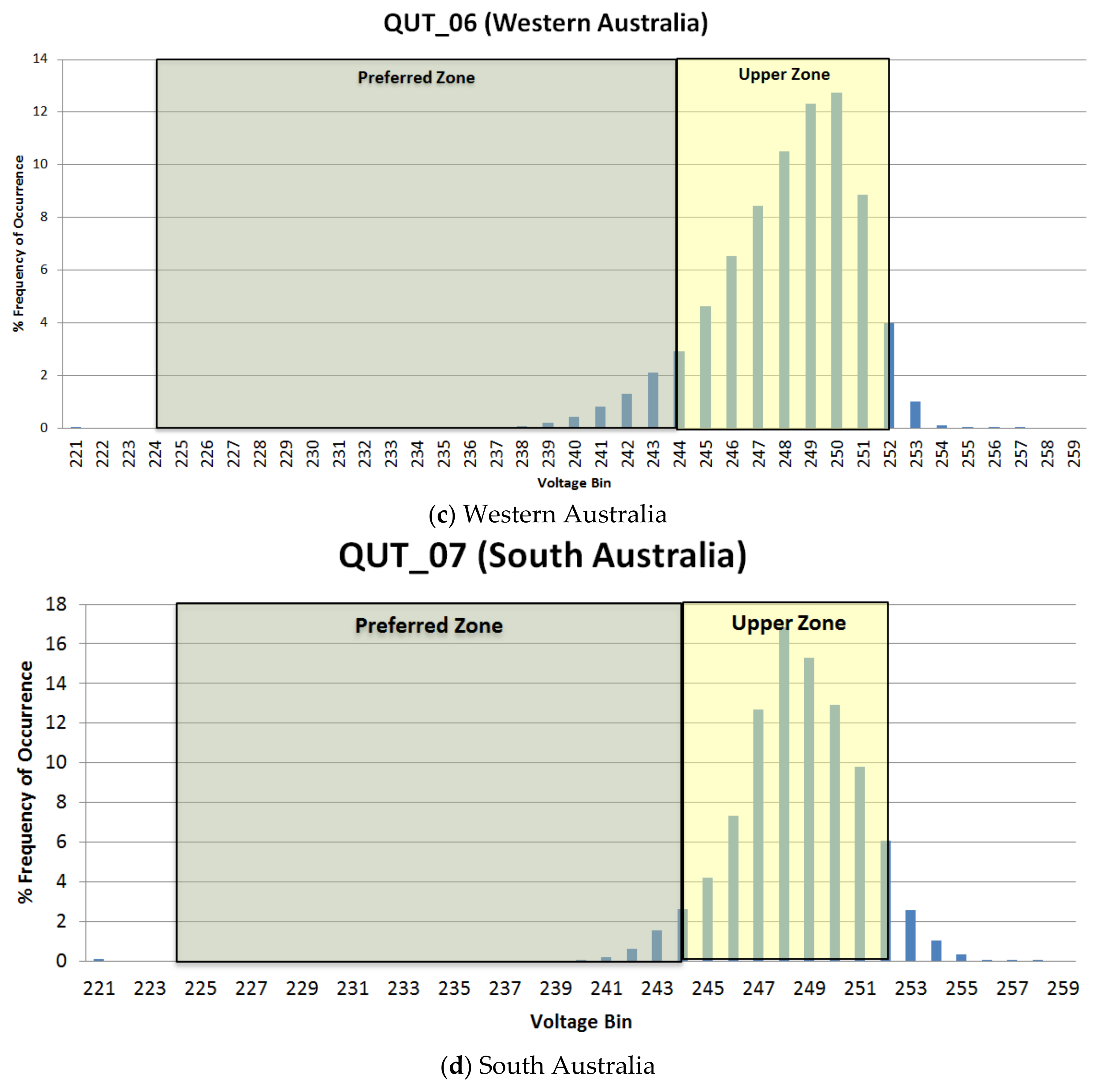
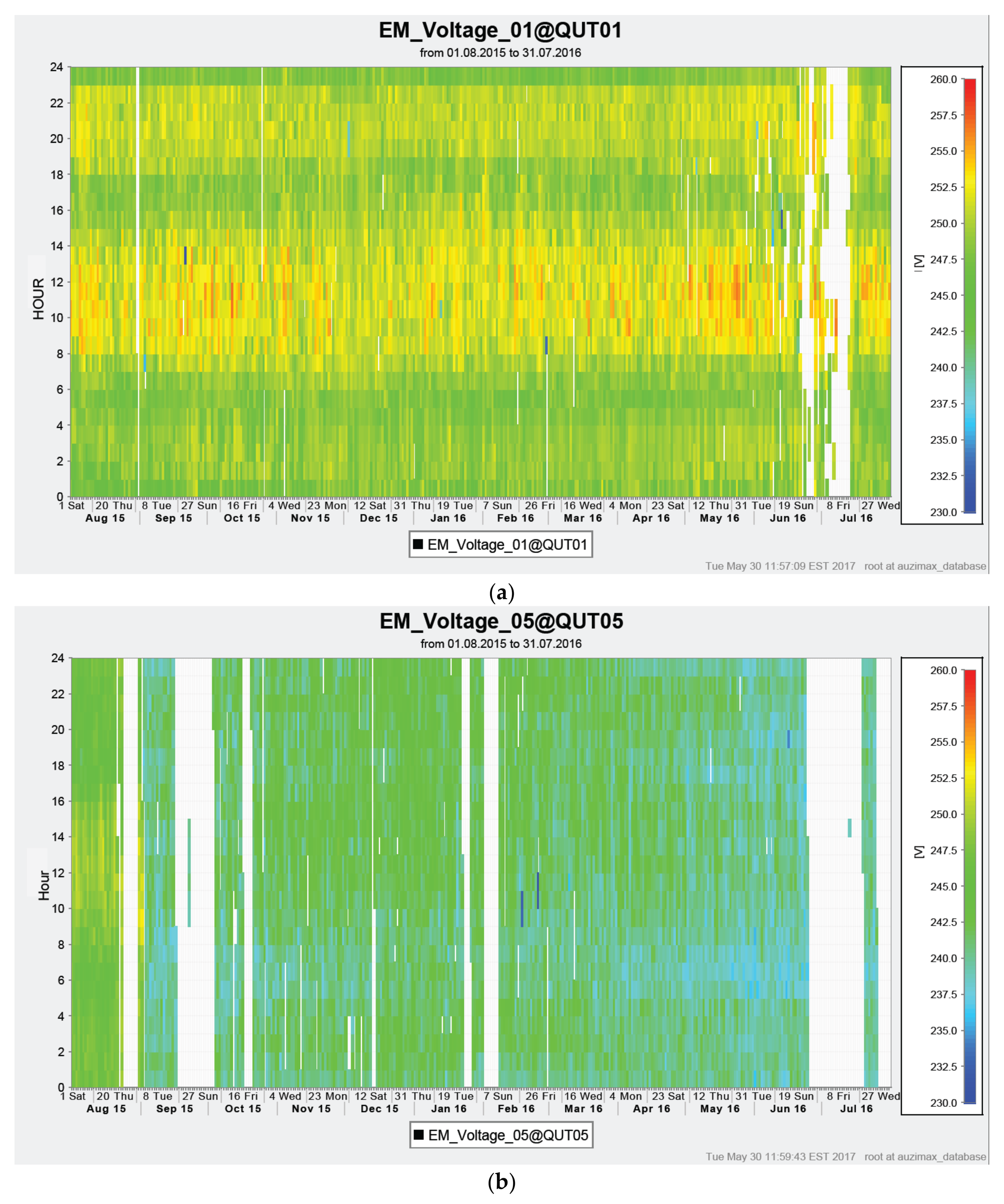
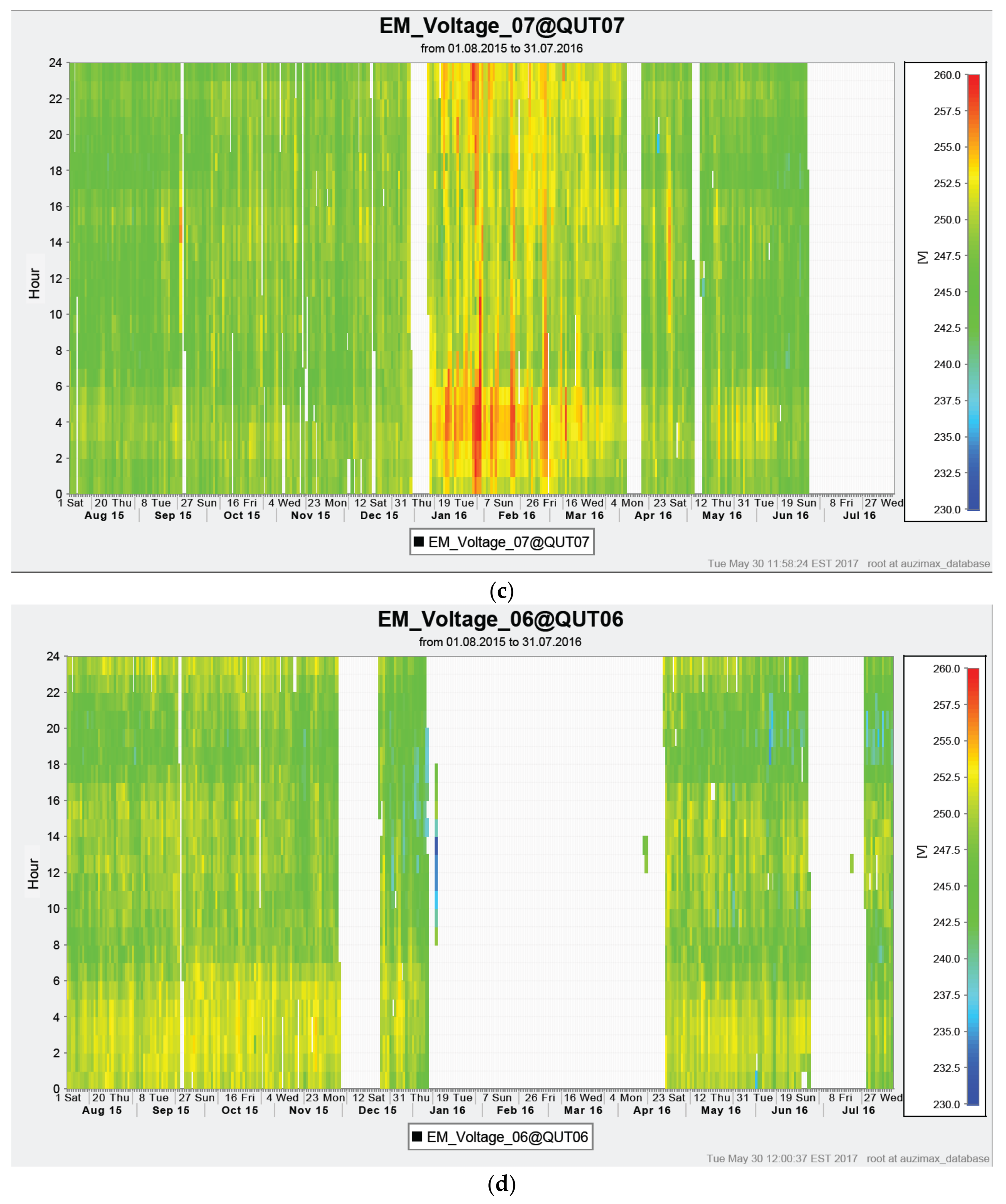
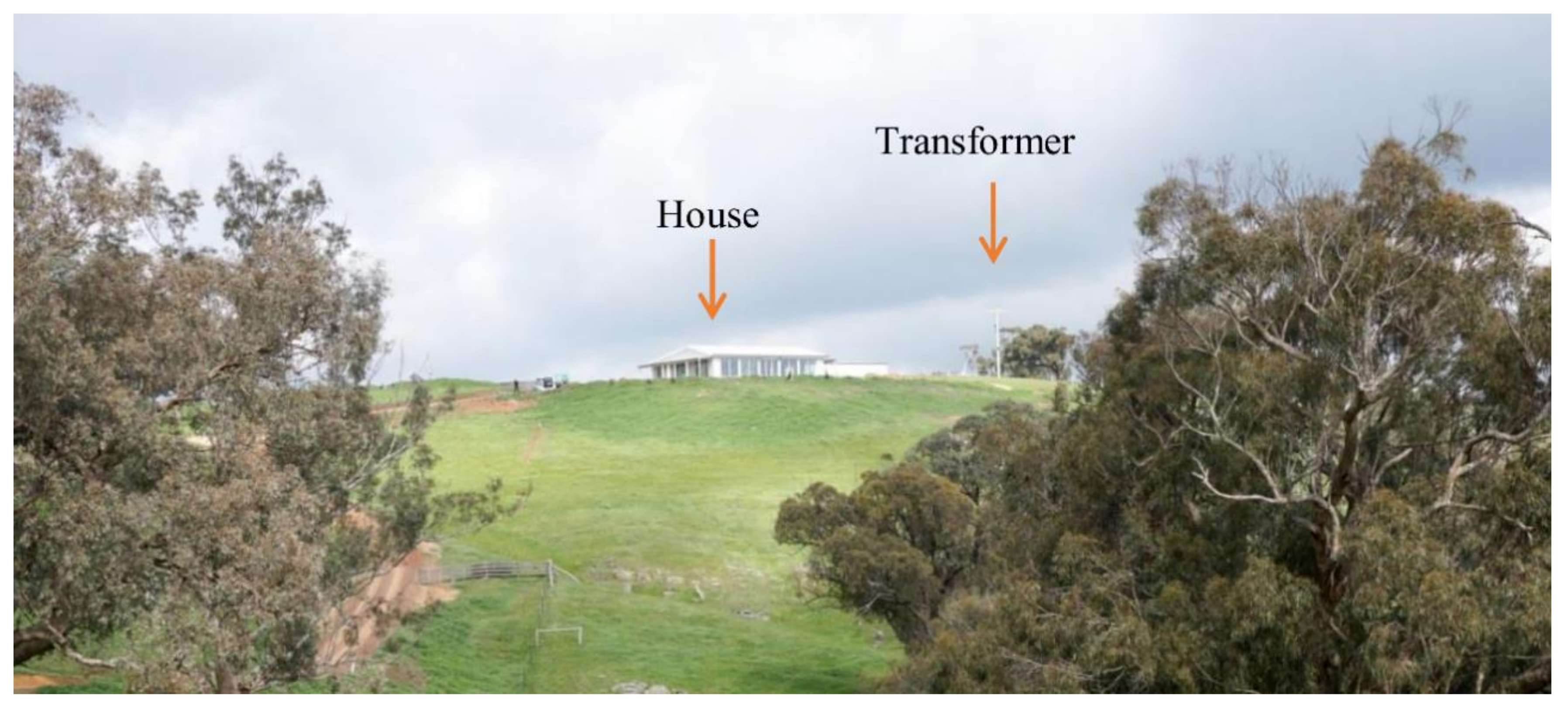
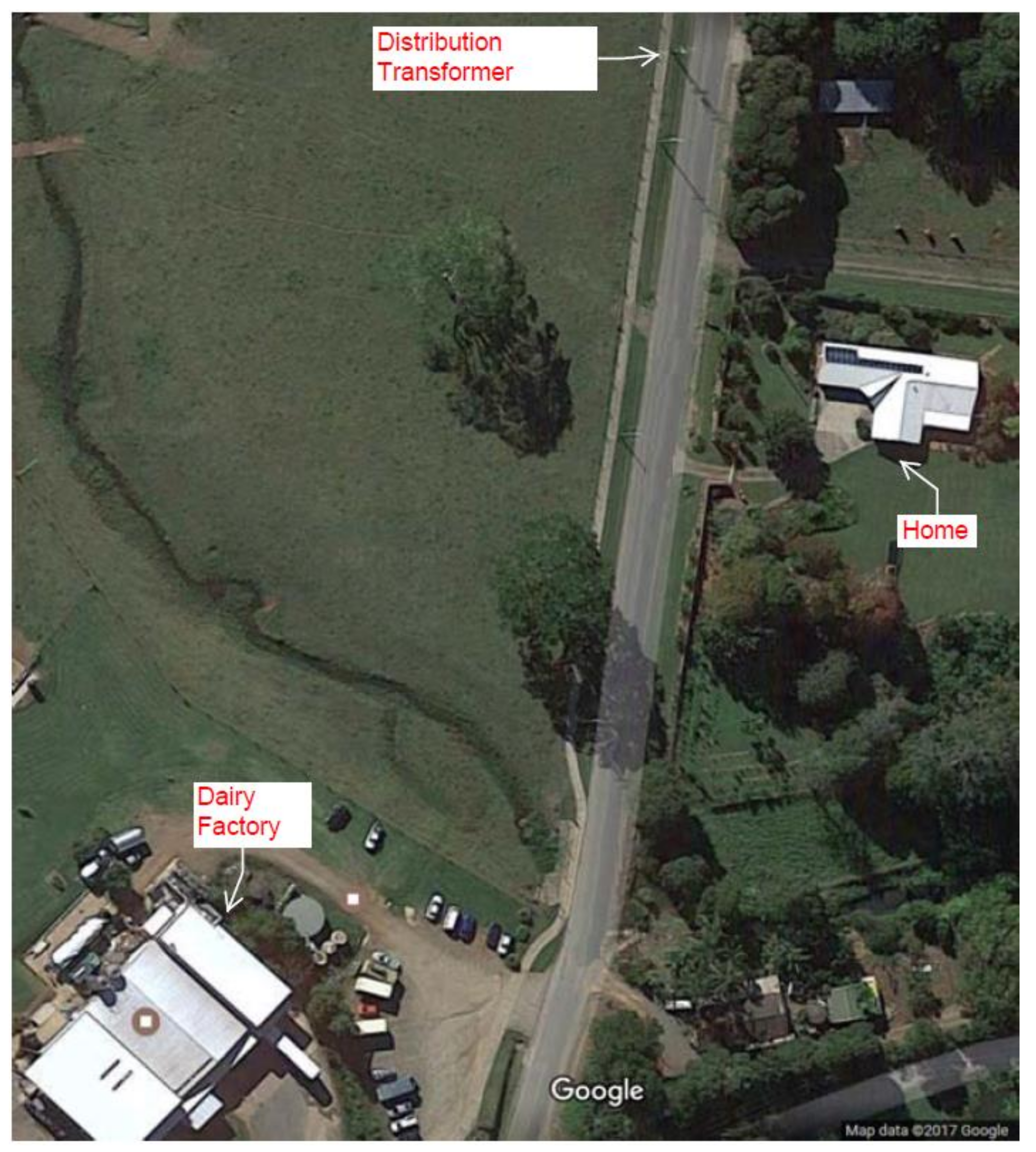
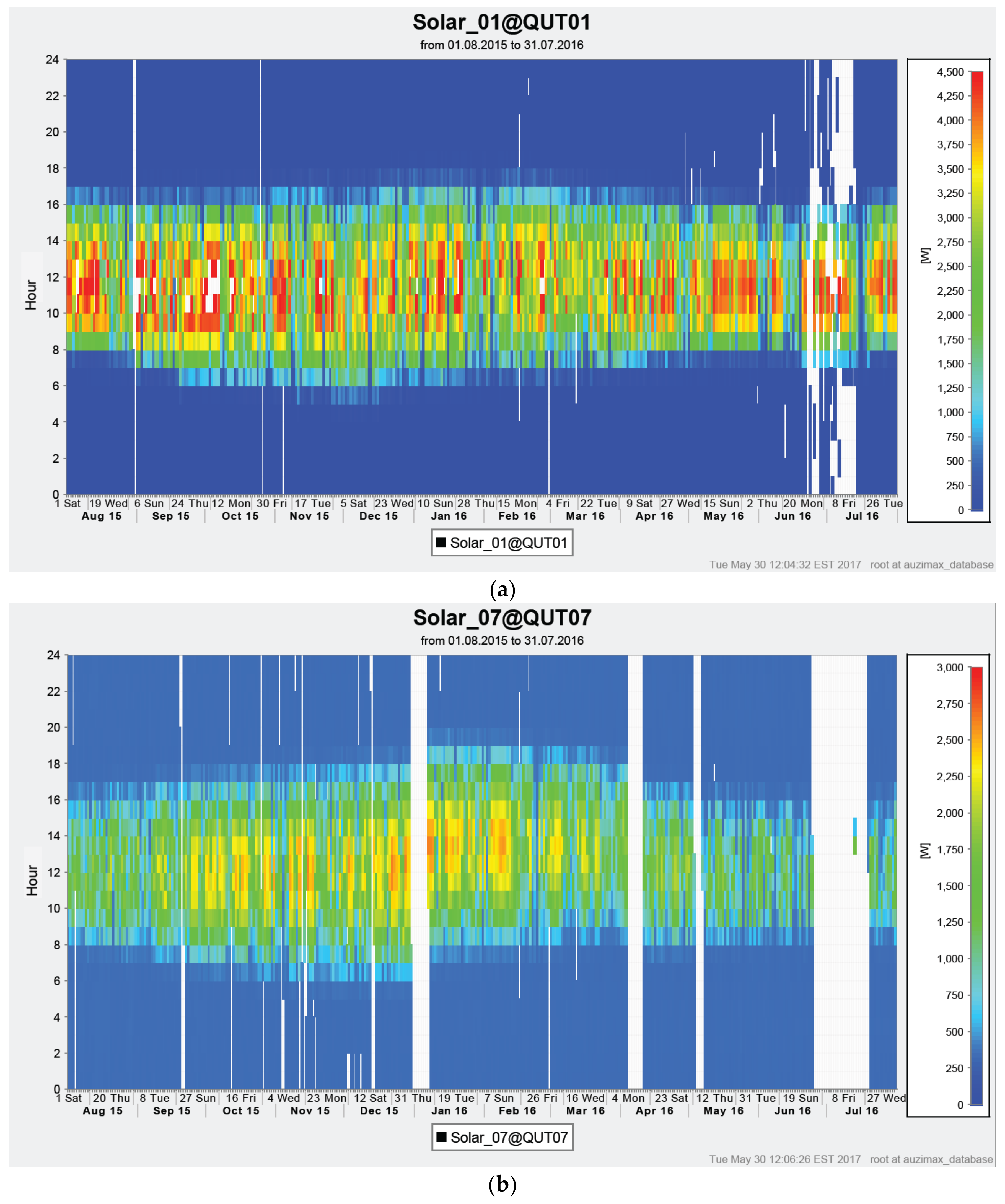
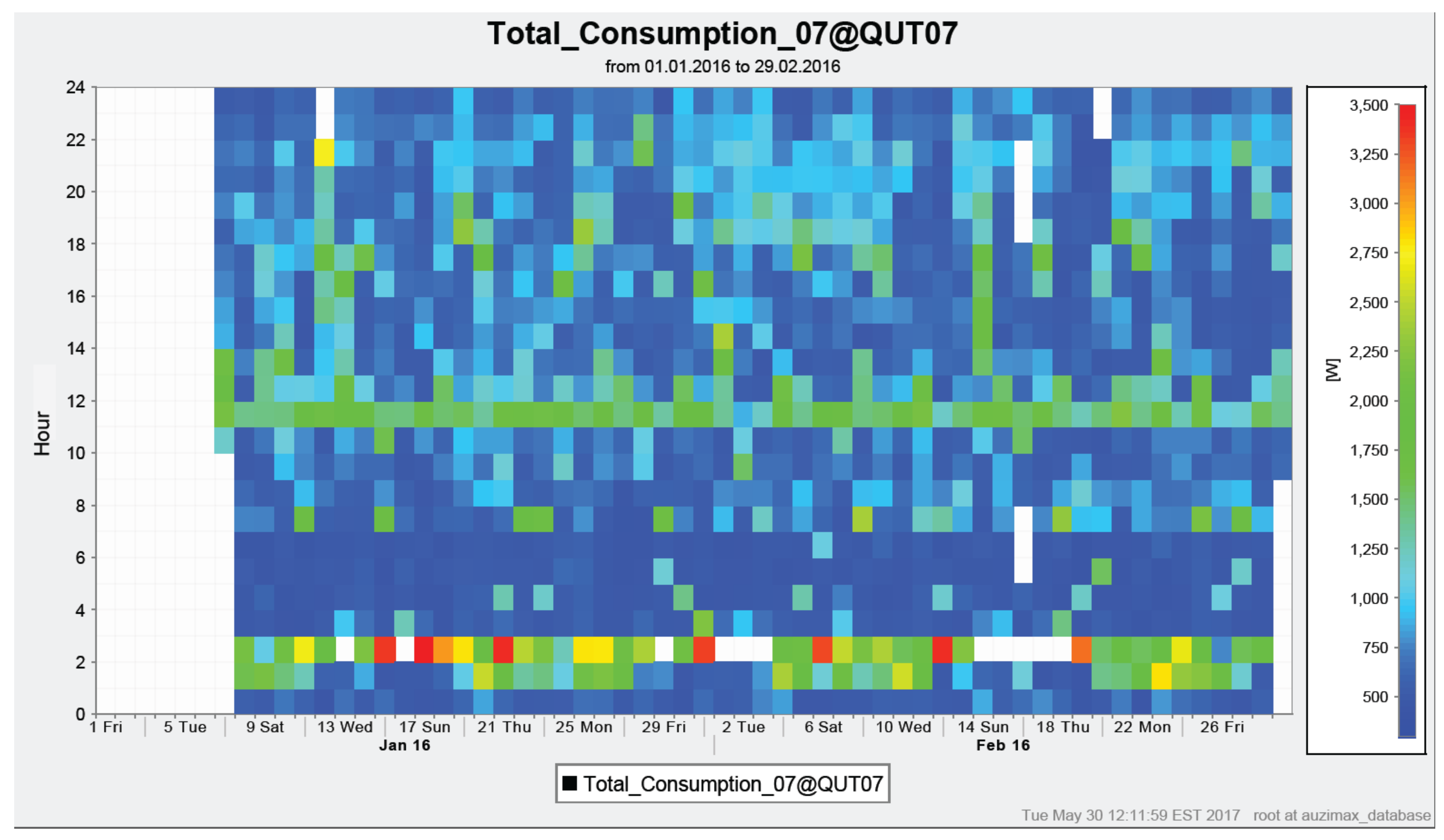
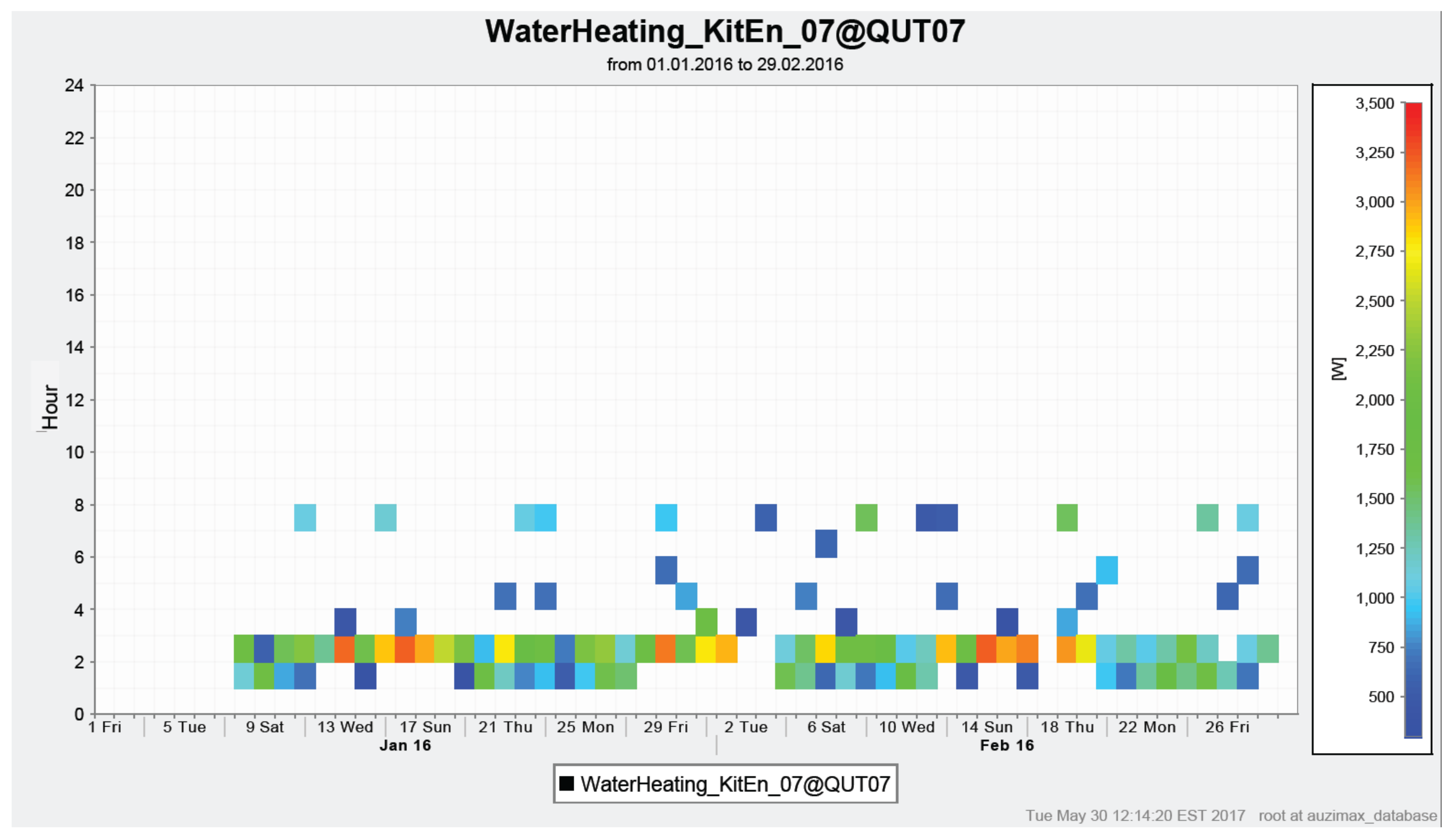
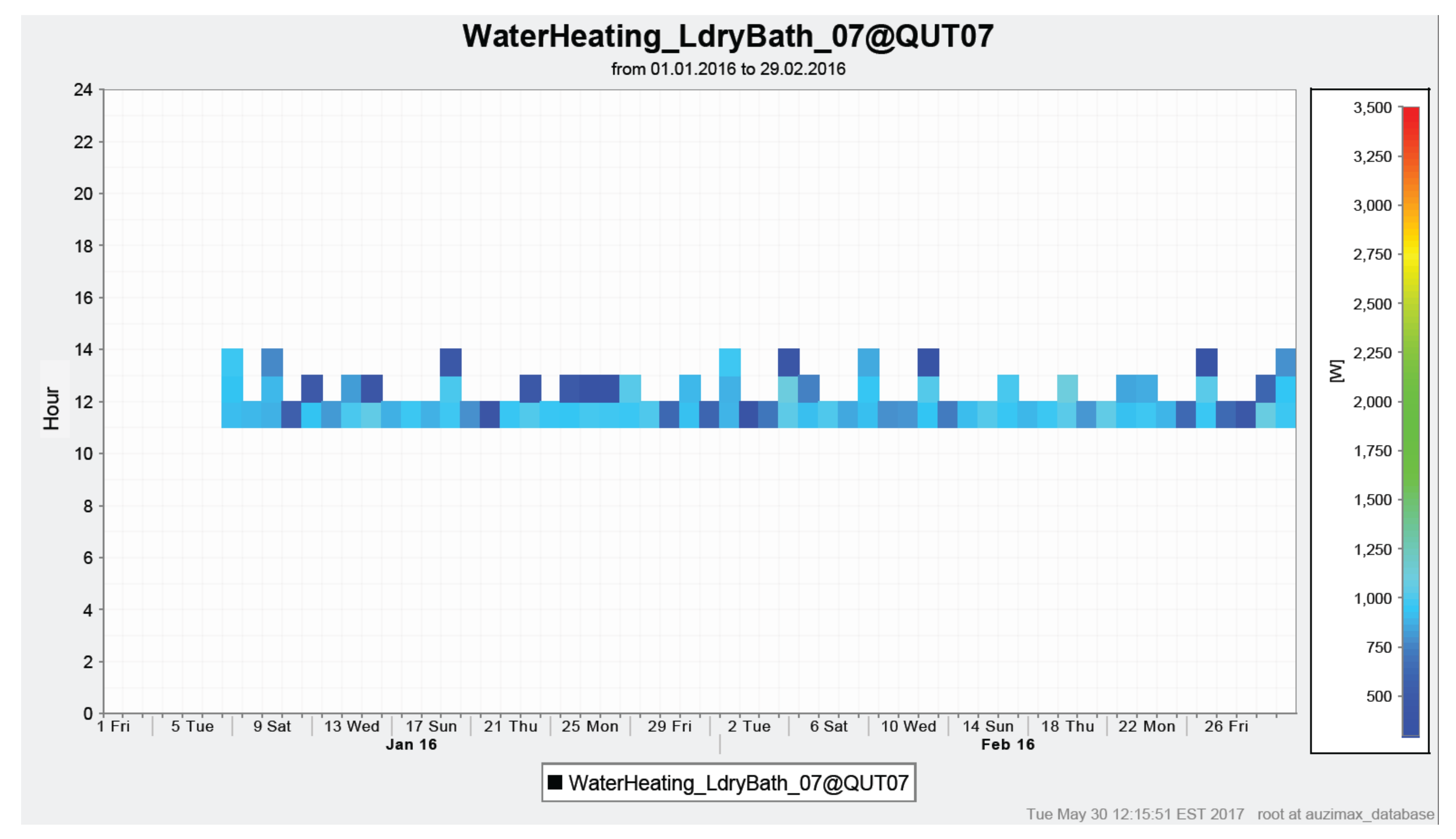
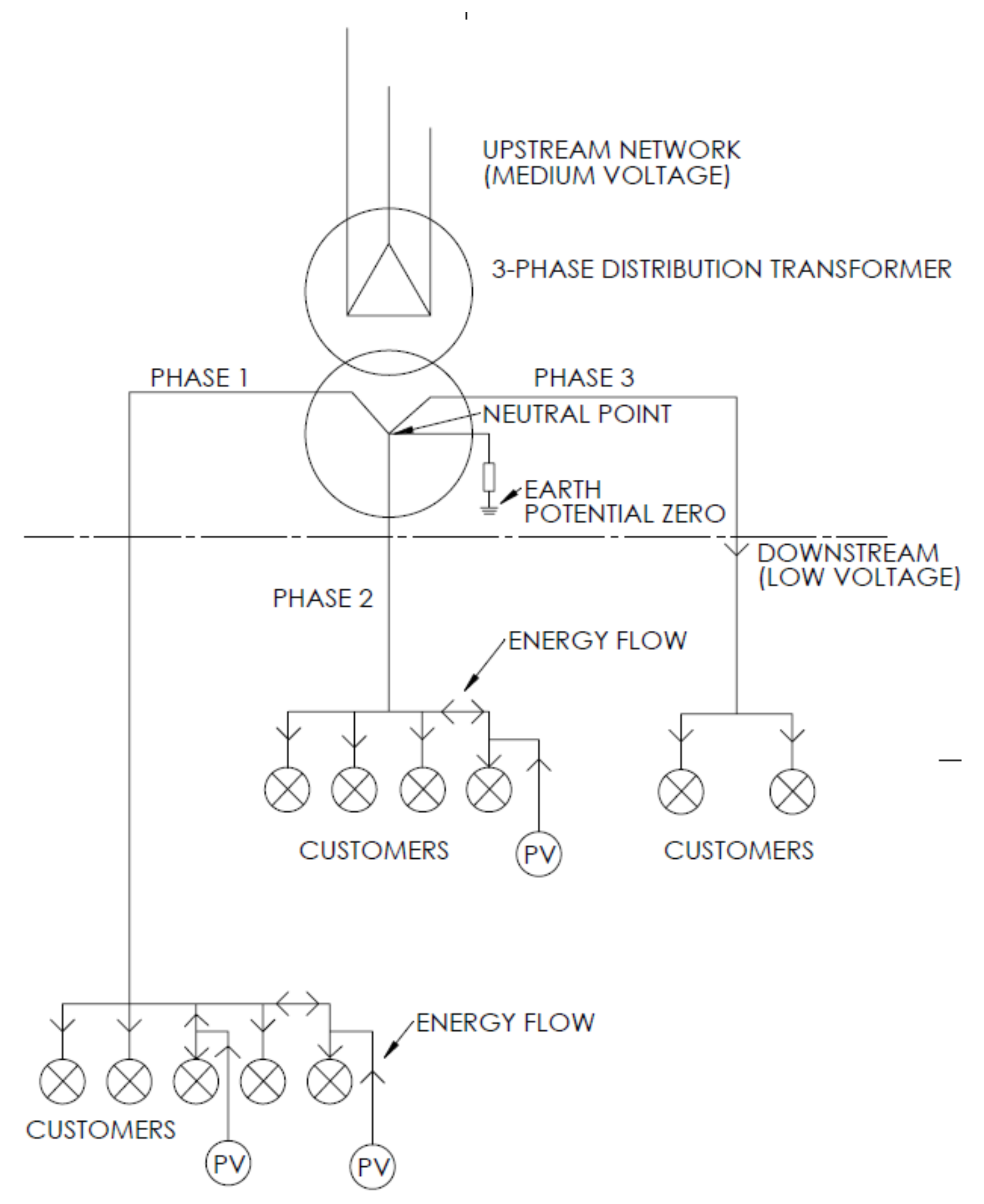
| Region/Country | Frequency under ‘Normal’ Operating Conditions | |
|---|---|---|
| Lower (Hz) | Upper (Hz) | |
| Australia [37] | 49.85 | 50.15 |
| Germany (EN50160) [38] | 49.5 | 50.5 |
| United Kingdom [39] | 49.5 | 50.5 |
| New Zealand [40] | 49.8 | 50.2 |
| South Africa [41] | 49.5 | 50.5 |
| United States (60 Hz) | Differing tolerances up to ±0.08 depending on the network | |
| Country/Region | Allowable Voltage at Customer’s Point of Supply | Voltage Range | Standard/Regulation/Reference |
|---|---|---|---|
| Germany | 230 V ±10% | 207–253 V | DIN EN50160 [42] |
| United Kingdom | 230 V +10%, −6% | 216.2–253 V | BS7671 [43] |
| USA | 120 V ±5% | ANSI Standard C84-1 (2016) [44] | |
| New Zealand | 230 V ±6% | Electrical (Safety) Regulations 2010 (NZ) | |
| Australian Standards | |||
| Pre-2000 | 240 V | AS 2926 (Pre-2000) | |
| 2000+ | 230 V +10%, −6% | 207–253 V | AS 60038-2012 Standard Voltages 1 |
| Australian DNSPs (Victoria, New South Wales, Tasmania, Northern Territory) | 230 V +10%, −6% (nominal) | 216.2–253 V | AS 60038-2012 and |
| 230 V +6.1% −2.2% (pref.) 2 | 225.4–243.8 V | AS 61000.3.100: Limits—Steady state voltage limits in public electricity systems (2011) | |
| Australian DNSPs 3 (Queensland, Western Australia, Australian Capital Territory) | 240 V ±6% | Electricity Regulation 2006 (QLD); WA Connections Manual and Technical Code; ACTEWAGL Service and Installation Rules. |
| State | Limits | Measuring Method | Requirement Imposed by | Penalty Tariff Structure (Non-Residential) |
|---|---|---|---|---|
| Victoria | 0.75 lagging to 0.8 leading but depends on voltage and demand | Not specified | Electricity Distribution Code | Fixed of Peak kW demand |
| Queensland | >0.8 to unity 0 not leading unless entity agrees | Over any 30 min | Electricity Regulation 2006 | kW capacity and actual demand charge |
| Western Australia | 0.8 lagging to 0.8 leading or per connection agreement | At period of daily peak demand | WA Electrical Requirements and distributor codes and rules | Western Power—Peak kVA demand |
| South Australia | 0.8 lagging to 0.8 leading but depends on voltage and demand | At monthly maximum demand | ETSA Utilities Service & Installation Rules | Peak kVA demand. Some old customers on kW demand |
| Nationally | 0.9 lagging to 0.9 leading but depends on voltage | Not specified | National Electricity Rules | N/A |
| State | Queensland | Western Australia | Victoria | South Australia |
|---|---|---|---|---|
| Latitude | 26.8° S | 31.92° S | 37.2° S | 37.75° S |
| Longitude | 152.8° E | 115.87° E | 145.05° E | 140.77° E |
| Climate | Subtropical | Warm Temperate | Cool Temperate | Cool Temperate |
| Summer Tmean Max °C | 26.5 | 30.7 | 23.9 | 24.5 |
| Summer Tmean Min °C | 18.0 | 17.6 | 11.8 | 11.0 |
| Winter Tmean Max °C | 20.2 | 19.0 | 9.8 | 13.7 |
| Winter Tmean Min °C | 9.7 | 8.2 | 4.4 | 5.5 |
| Context | Semi-urban | Suburban | Rural | Suburban |
| Property Type | Detached single family home | Detached single family home | Detached single family home | Detached single family home |
| Floor Area | 221.1 m2 | 275 m2 | 246.3 m2 | 278 m2 |
| Occupants | 2 Adults & 2 Children | 2 Adults & 2 Children ** | 2 Adults | 2 Adults & 3 Children |
| Nominal Voltage | 240 V | 240 V | 230 V | 230 V |
| Hot Water | Electric | Natural Gas | Solar/Electric boost | Heat Pump & Electric |
| Space Heating | Wood heater | Nil | Wood heater | Hydronic Floor heating |
| Space Cooling | Ceiling Fans | Nil | Nil | Nil |
| PV System Size/Inverter type | 6 kWp String inverter | Nil | 3.6 kWp String inverter | 3 kWp (Microinverters) |
| Grid connection | Single Phase | 3 phase | 3 phase | Single phase |
| Distance from LVDN Transformer | 150~200 m | unknown | >50 m | 65 m |
| DNSP | Energex | Western Power | AusNet. | SA Power Networks |
| Q15 | Q16 | Q17 | Q18 | |
|---|---|---|---|---|
| Climate | Subtropical | Subtropical | Subtropical | Subtropical |
| Urban Context | Suburban | Suburban | Suburban | Suburban Fringe |
| Building type | Detached house (Constructed 1974) | Detached house (Constructed 2016) | Residential community (110 apartments constructed circa 2006) | Residential Community Common Facilities (constructed circa 2010) |
| Occupants | 2 adults, 3 children | 2 adults | Senior Adults (80+ year) | NA |
| PV system size/Inverter type | 1.6 kWp String inverter | 3 kWp String inverter | 110 × 1 kWp with String inverter | 5 kWp String inverter |
| Grid connection | Single phase (since 2000) | Single phase (since 2016) | Three phase—microgrid (since 2012); 2 points of connection to network | Three phase (since 2013) |
| DNSP | Energex | Energex | Energex | Energex |
| Data collection type | Household records | Household records | Community Records, kWh meters | Community records |
| Queensland | Victoria | Western Australia | South Australia | |
|---|---|---|---|---|
| Mean voltage V | 249.7038 | 240.6472 | 247.5672 | 248.7791 |
| Standard deviation | 7.767765 | 5.460625 | 15.89345 | 8.25179 |
| Q1 | 248.3 | 239.4 | 246.9 | 247.6 |
| Q2 | 249.8 | 240.8 | 249 | 249 |
| Q3 | 251.4 | 242.2 | 250.5 | 250.6 |
| Max. V | 258.6 | 253.6 | 257.2 | 258.8 |
| Case Study | Queensland | |||||||||||
|---|---|---|---|---|---|---|---|---|---|---|---|---|
| Month → Power quality ↓ | 15 Apr. | 15 May. | 15 Jun. | 15 Jul. | 15 Aug. | 15 Sep. | 15 Oct. | 15 Nov. | 15 Dec. | 16 Jan. | 16 Feb. | 16 Mar. |
| Mean Frequency Difference (50 Hz) | 0.01 | 1.28 | 0.009 | 0.006 | 0.003 | 0.01 | 0.007 | 0.01 | 0.006 | 0.007 | 0.002 | 0.007 |
| % Time within Frequency Standard (49.85–50.15 Hz) | 99.9 | 99.9 | 99.9 | 99.9 | 99.9 | 99.9 | 99.9 | 99.9 | 99.9 | 99.9 | 99.9 | 99.9 |
| Mean Voltage Difference (St. 240 V) | 10.3 | 3.75 | 9.23 | 9.89 | 10.22 | 9.61 | 9.94 | 10.08 | 9.56 | 9.87 | 9.89 | 9.82 |
| % Time within Standard (240 V +−6%) | 94.3 | 89.9 | 99.03 | 96.21 | 92.65 | 95.97 | 95.9 | 93.17 | 97.28 | 95.07 | 97.76 | 96.2 |
| Mean Power Factor Difference (Deviation below unity pf 1) | 0.18 | 0.2 | 0.16 | 0.202 | 0.21 | 0.11 | 0.175 | 0.066 | 0.098 | 0.22 | 0.122 | 0.14 |
| Case Study | Western Australia | |||||||||||
| Month → Power quality ↓ | 15 Jul. | 15 Aug. | 15 Sep. | 15 Oct. | 15 Nov. | 15 Dec. | 16 Jan. | 16 Feb. | 16 Mar. | 16 Apr. | 16 May. | 16 Jun. |
| Mean Frequency Difference (50 Hz) | NA | 0.006 | 0.005 | 0.01 | 0.015 | 0.004 | 0.014 | NA | NA | 0.36 | 0.31 | 0.19 |
| % Time within Frequency Standard (49.8–50.2 Hz) | NA | 99.9 | 99.9 | 99.9 | 99.9 | 99.9 | 99.9 | NA | NA | 99.9 | 99.9 | 99.9 |
| Mean Voltage Difference (St. 240 V) | NA | 7.68 | 9.28 | 9.2 | 9.02 | 7.19 | 5.47 | NA | NA | 8.48 | 8.44 | 6.39 |
| % Time within Standard (240 V +−6%) | NA | 99.9 | 99.5 | 99.9 | 99.9 | 99.9 | 99.9 | NA | NA | 99.8 | 99.9 | 99.9 |
| Mean Power Factor Difference (Deviation below unity pf 1) | NA | 0.48 | 0.61 | 0.6 | 0.6 | 0.59 | 0.53 | NA | NA | 0.36 | 0.31 | 0.19 |
| Case Study | Victoria | |||||||||||
|---|---|---|---|---|---|---|---|---|---|---|---|---|
| Month → Power quality ↓ | 15 Jul. | 15 Aug. | 15 Sep. | 15 Oct. | 15 Nov. | 15 Dec. | 16 Jan. | 16 Feb. | 16 Mar. | 16 Apr. | 16 May. | 16 Jun. |
| Mean Frequency Difference (50 Hz) | 0.014 | 0.011 | 0.01 | 0.008 | 0.0004 | 0.002 | 0.004 | 0.009 | 0.006 | 0.007 | 0.007 | 0.006 |
| % Time within Frequency Standard (49.85–50.15 Hz) | 99.9 | 99.9 | 99.9 | 99.9 | 99.9 | 99.9 | 99.9 | 99.9 | 99.9 | 99.9 | 99.8 | 99.8 |
| Mean Voltage Difference (St. 230 V) | 6.06 | 16.6 | 10.26 | 10.89 | 11.46 | 11.63 | 12.29 | 8.17 | 11.14 | 10.89 | 10.35 | 9.63 |
| % Time within Standard (230 V +10%, −6%) | 100 | 99.9 | 100 | 100 | 100 | 100 | 100 | 97.3 | 100 | 100 | 100 | 100 |
| Mean Power Factor Difference (Deviation below unit pf 1) | 0.14 | 0.13 | 0.74 | 0.41 | 0.38 | 0.34 | 0.18 | 0.23 | 0.18 | 0.22 | 0.17 | 0.18 |
| Case Study | South Australia | |||||||||||
| Month → Power quality ↓ | 15 Jul. | 15 Aug. | 15 Sep. | 15 Oct. | 15 Nov. | 15 Dec. | 16 Jan. | 16 Feb. | 16 Mar. | 16 Apr. | 16 May. | 16 Jun. |
| Mean Frequency Difference (50 Hz) | NA | 0.045 | 0.008 | 0.008 | 0.01 | 0.007 | 0.007 | 0.003 | 0.007 | 0.009 | 0.013 | 0.008 |
| % Time within Frequency Standard (49.85–50.15 Hz) | NA | 99.8 | 99.9 | 99.8 | 99.9 | 99.9 | 99.9 | 99.9 | 99.9 | 99.9 | 99.2 | 99.3 |
| Mean Voltage Difference (St. 230 V) | NA | 16.4 | 17.24 | 18.13 | 18.33 | 18.56 | 21.67 | 21.67 | 20.58 | 19.4 | 15.5 | 15.36 |
| % Time within Standard (230 V +10%, −6%) | NA | 99.9 | 99.1 | 99.9 | 99.9 | 99.9 | 70.9 | 78.3 | 93.3 | 99.9 | 98.7 | 98.7 |
| Mean Power Factor Difference (Deviation below unity pf 1) | NA | 0.19 | 0.2 | 0.17 | 0.18 | 0.17 | 0.19 | 0.2 | 0.19 | 0.21 | 0.25 | 0.24 |
| Case Study | Issues Encountered with DNSP |
|---|---|
| Q15 (end-user records) | This household was one of the first grid-connected PV households in Queensland (in 2000). The DNSP required the household to sign a comprehensive network agreement stipulating the conditions under which the PV system needed to operate in order to not impact on the safety and security of the network. There were no reciprocal clauses. Over the first few years of operation the PV system inverter kept tripping out, for no known reason. After much investigation initiated by the owner, it was found that control signals sent by the DNSP down the wires for controlling hot water systems were inadvertently turning off the inverter. This was resolved by the DNSP connecting the house supply to a different phase on the transformer. Previously no consideration was given by the DNSP regarding what phase a solar household should be connected to in order to avoid such a network issue or to assist the network in balancing local loads/distributed generation. |
| Q16 (end-user verbal report validated against DNSP rules) | This household has a newly constructed house (2016) with a 5 kWp PV and 5 kW string inverter. In a response to the DNSP’s concerns about network voltage fluctuations, new local regulations required the PV installer to limit the output capacity of the inverter 4.5 kW. Whilst this may have benefit for the network, it also had a consequence of limiting the PV production onsite, reducing the capacity of the household for self-consumption. This issue was raised with the DNSP by various customers and the local ‘rule’ has been rescinded. Grid export is limited to 5 kW. |
| Q17 (measured data/network analysis) | This 3-phase residential community network has two points of connection to the local DNSP and has 110 x 1 kWp rooftop PV systems, each with its own small unity-power factor inverter. Neither loads nor PV generation units were evenly distributed across all three phases of the community network, resulting in overvoltage issues. These issues led to the DNSP requiring a large number of PV inverters to be switched off, so the overvoltage issue would not affect its network. Phase balancing in private networks (e.g., at a building or community level) is also important yet seems little understood by electrical engineers/contractors who design and install such systems. |
| Q18 (end-user verbal report validated by engineering report) | A community recreation centre (hall, swimming pool, small gym, library etc.) installed a 5 kWp PV system to provide carbon neutral power to its facilities. The energy loads (e.g., swimming pool pumps and filtration, lighting, refrigeration, communications equipment) were not evenly distributed across the three phases. The PV system was connected to a single phase only. Again, this is an electrical engineer/contractor issue. The importance of phase balancing—for local loads and generation—does not seem to be widely understood. |
| DNSPs Are Active in... | DNSPs Could Be Active in... |
|---|---|
| Influencing regulation of residential rooftop PV systems | Influencing regulation of some customer loads (e.g., air conditioning) that have become a major concern for peak demand management (DNSPs provide incentives for managing these loads but are not actively involved in regulations regarding these loads) |
| Planning to implement demand charges (kVAR) at a residential level | Lobbying/regulating power factor standards for residential equipment (Australia has minimum energy performance standards for many appliances, yet power factor is not a factor in these standards.) |
| Limiting the size of PV permitted at a household level (network connected) | Actively promoting balancing of household load with PV size or balancing at a neighbourhood level |
| Promoting energy efficient heating and cooling appliances | Actively lobbying for better building regulations (higher energy efficiency standards to reduce space heating and cooling demand) |
| Measuring power quality at a substation level | Measuring and reporting power quality at the point of customer connection |
© 2018 by the authors. Licensee MDPI, Basel, Switzerland. This article is an open access article distributed under the terms and conditions of the Creative Commons Attribution (CC BY) license (http://creativecommons.org/licenses/by/4.0/).
Share and Cite
Miller, W.; Liu, A.; Amin, Z.; Wagner, A. Power Quality and Rooftop-Photovoltaic Households: An Examination of Measured Data at Point of Customer Connection. Sustainability 2018, 10, 1224. https://doi.org/10.3390/su10041224
Miller W, Liu A, Amin Z, Wagner A. Power Quality and Rooftop-Photovoltaic Households: An Examination of Measured Data at Point of Customer Connection. Sustainability. 2018; 10(4):1224. https://doi.org/10.3390/su10041224
Chicago/Turabian StyleMiller, Wendy, Aaron Liu, Zakaria Amin, and Andreas Wagner. 2018. "Power Quality and Rooftop-Photovoltaic Households: An Examination of Measured Data at Point of Customer Connection" Sustainability 10, no. 4: 1224. https://doi.org/10.3390/su10041224






